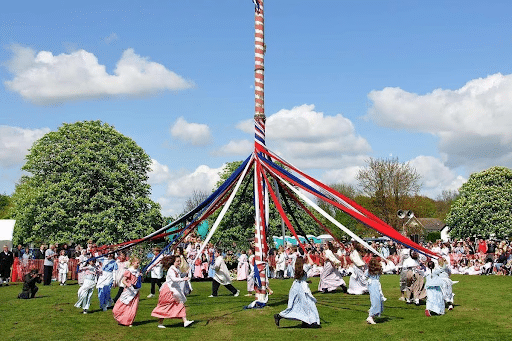May Day – a day of dancing, protest and controversy
Dear all
I hope you enjoyed last week’s three-day weekend. On Tuesday, I asked our students how many knew anything about the origins, evolution – and controversy – that lies behind the May Day Bank Holiday, which goes back hundreds of years, was frowned upon by some as a pagan festival that was then superseded by political sentiment and disagreement.
The earliest May festivities can be traced back to the Roman festival of Floralia, in honour of Flora, the goddess of flowers, with competitions, performances and sacrifices. Closer to home, Celts would mark the changing seasons with an astronomical holiday called Beltane, which marked the opening of pastures for summer grazing and involved singing, dancing, bonfires, and the maypole, which became the feature perhaps most people might associate with the May Day Bank Holiday. Dancing around the maypole symbolised fertility at a time of year when nature emerged from the winter cold.
With the progress of Christianity, these May Day traditions were infused with or appropriated: the Catholic church, for example, renamed the day the Queen of May in the 18th century, in honour of the Virgin Mary. Not all Christians approved, however – Oliver Cromwell banned the May Day celebrations as part of his Puritan agenda (he also banned celebrations at Christmas and Easter, all of which were restored after his death, of course).
Perhaps the most significant chapter of the history of May Day came with the advent of Socialism in the late 1800s, however. In 1889, the Second Socialist International (an organisation that coordinated actions by groups in different countries to promote and agitate for the rights of workers) proclaimed May 1st as International Workers’ Day in honour of the Haymarket Martyrs of Chicago, 10 anarchists who had protested for an eight-hour working day and were subsequently executed. May Day became a day for workers to demand better conditions, with mass demonstrations, marches and festivals occurring across the world.
In Britain, the first May Day protests coincided with a period of strikes as thousands of workers joined Trade Unions to pool resources and force their bosses to improve their pay and conditions. 300,000 people gathered in London’s Hyde Park in 1890 for example, demanding a maximum working day of eight hours. One of the main speakers at the protest was Eleanor Marx, daughter of Karl Marx, who famously proclaimed ‘Ye are many they are few’ in an attempt to inspire collective action against employers.
However, while there had been a public holiday in Scotland since 1871, it wasn’t until 1978 that May Day was turned into a Bank Holiday across the UK. It took two years of effort by the Labour government to get the law passed because many other members of parliament viewed it as an ‘unBritish’ holiday due to its socialist links. Even when it was passed into law, for example, some shopkeepers in Sussex vowed to stay open, and the Executive Club in Folkestone flew the St George’s flag at half-mast, expressing their displeasure. Ironically, many workers also lost out financially because although it was now a Bank Holiday, employers were not obliged by law to pay their staff for this new holiday. Even the grave of Karl Marx (in Highgate Cemetery, which is well worth a visit, by the way) was embroiled in the controversy as opponents poured red, white, and blue paint over it. In 1982, there was an attempt to abolish the holiday – Margaret Thatcher had become Prime Minister in 1979 and her Conservative Government had just triumphed against Argentina in the Falklands War. On the back of this, there was a move by some in her party to replace May Day with a different Bank Holiday that was ‘more in keeping with the traditions of England’. Perhaps conscious of the controversy that might surround this change, the idea wasn’t pursued to fruition.
Today, May Day – like so many aspects of our culture – remains a blend of different traditions: many villages still have Maypole dancing and spring festivals; some celebrate it as an ‘International Day of Labour’ and remember the struggle for workers’ rights; many communities see it as an opportunity to spend time together after a long winter; while I suspect most of us who are lucky enough not to have to go to work or school that day just enjoy it as an extra day off. Whichever category we fall into, it’s interesting to know the history – and controversy – behind the Bank Holiday we’ve just enjoyed.
Have a great (albeit only two-day) weekend
Best wishes
Michael Bond




